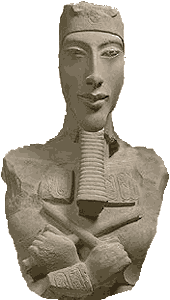Introduction to the Amarna Period

Akhenaten - Amenophis IV Pharaoh of Akhet-Aten |
|
|
Unfortunately, Akhenaten's changes were short-lived, and the capital was moved back to Thebes within two decades. The end of his reign is shrouded in mystery: his wife left him or died, he shared the throne momentarily with Smenkhkare, of which little is known, and after his death, Tutankhaten, at the age of about ten years, returned his country to the old ways, probably under the direction of other political forces. Soon after, Horemheb restored Egypt with vigour, removing references to Akhenaten from monuments, and effectively erasing him from Egyptian history. The archaeologically verified details are few. Akhenaten is now a figure of mythic proportion; theory and speculation pile upon speculation and theory. His charisma, even after so many millenia, has led him to be adopted by numerous religions and cults as founder or member. He has been 'discovered' as the true identity of Moses, and of Oedipus. He has been touted as one half of history's first gay couple (the other half being Smenkhkare). Nefertiti, for her part, is no less controversial and mysterious. Did she share the throne as a full Pharaoh, as Hatshepsut had done before her, rather than disappearing as we originally thought? And was Smenkhkare simply another name for the Pharaoh Nefertiti? What happened to Tutankhamun at so young an age? Dare we speak of murder? These questions and theories have carried us far on so little primary data, and the study of the study of the Amarna period is interesting in itself! Please explore the mysteries by choosing a topic at the left. |
![]()
|
|
This page is part of The
Akhet-Aten Home Page |
